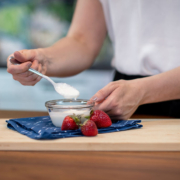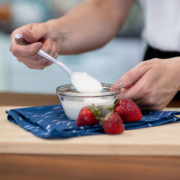Are the microbes in fermented foods safe? A microbiologist helps demystify live microbes in foods for consumers
By Dr. Gabriel Vinderola, PhD, Associate Professor of Microbiology at the Faculty of Chemical Engineering from the National University of Litoral and Principal Researcher from CONICET at the Dairy Products Institute (CONICET-UNL), Santa Fe, Argentina.
Since very early in my career I was drawn to science communication. I feel that rather than just producing my own results, silently in my lab, I can extend the reach of the science by amplifying other people’s work. At least in the southern cone where budgets for research have been always limited, science communication is a way to be active in science.
Before the pandemic I used my Instagram account mostly to share personal moments with my circle of family and friends. But when the COVID-19 pandemic hit, I saw interest in fermented foods skyrocket. I started sharing tips about how to prepare fermented foods, telling the science behind them, separating myths from facts, making Instagram Live videos with fermentationists, nutritionists, pediatricians and gastroenterologists, and I turned my personal Instagram account into a public one with an outreach of more than 100,000 followers (@gvinde), from Mexico down to Argentina.
During the pandemic, people were largely homebound and concerned about staying healthy. The idea of healthy food to keep a diverse gut microbiome that had the potential to enhance our gut and respiratory immune systems against coronavirus really resonated with people. I even had the chance to participate in several radio and TV programs discussing these topics as well as making yoghurt, kefir, kombucha, sauerkraut and sourdough bread at home. I saw that people had the time to devote part of their days at home to keep these communities of microbes “cooking” for them. But these activities revealed to me that more people than I realized did not know that we can eat microbes in a safe way and that they may actually be good for us.
In my encounters, I found much confusion about fermented dairy products. People believe that dairy products must be kept refrigerated, but at the same time they see ultrapasteurized milk, powdered milk or hard cheeses marketed at room temperature. People find it difficult to understand why pasteurized milk should go in the refrigerator but not unopened ultrapasteurized milk.
Some hesitancy around bacterial safety exists because Argentina leads the world in annual cases of Uremic Hemolitic Syndrome (UHS), a life-threatening condition for children, especially those under the age of 5 years, caused by shiga-toxin producing Escherichia coli. Almost 400 children get sick in Argentina every year due to UHS. Among other recommendations, pediatricians tell parents not to offer their children unpasteurized dairy products. This leads to the the most common question I receive on Instagram from parents worried about yoghurt safety: Is yoghurt pasteurized? “No!” I emphasize. “Yoghurt is not pasteurized, but it is made out of pasteurized milk. In fact, yoghurt has viable bacteria.” And this is when the panic begins.
“If yoghurt has live bacteria, then can’t any bacteria grow there, even the bacteria responsible for UHS? If I leave yoghurt outside the refrigerator or in my car too long, won’t this make it more likely that the UHS bacteria will grow?” This is where I try to use an army of arguments to communicate science in the simplest possible way, from more philosophical to more science-based facts.
The first thing I share is that fermentation was invented well before refrigerators. Fermentation was used by people to preserve foods, for periods well longer than the time it takes to take the yoghurt from the supermarket to make it home or than the time a yoghurt sits in the backpack of my child waiting for school lunchtime. I once posted that I ate a yoghurt that was left in my car for one whole day. That generated a lot of debate on social media!
Then I inform them that the fermentation process to make yoghurt causes the pH to drop well below values needed for pathogens to grow. That it is highly unlikely that a pathogen can enter a well-sealed yoghurt, and in the event that it would be possible, the acidic conditions would impair the pathogen from growing to a level that could be life-threating.
People not only worried about yoghurts bought in the supermarket, well-sealed and made under the strictest safety conditions in industry. In the pandemic many parents learned how to make yoghurt at home, and they wanted to know how safe it is. In these cases, I advised the following to assure their homemade yogurt was safe: use a yoghurt from the supermarket to launch your own fermentation, use pasteurized milk, use good quality water to wash your kitchen devices, and wash your hands properly. In addition you can use a domestic pHmeter or pH indicators to make sure pH dropped below 4.5. In a successful fermentation – after about 1 gallon sitting 8-12 hours at a warm temperature – the fluid milk will transform into a gel. If not, you should discard it.
If these arguments are not enough, then I draw their attention to the well-respected product milk kefir. At least in this region, kefir is surrounded by a halo of “something that is good, no matter what”. People are familiar with the process of fermenting milk kefir at room temperature for a full day. So I make this comparison: commercial yoghurt is fermented for 6 hours, then it is refrigerated and taken to the supermarket. If you are OK letting milk kefir ferment for a whole day, shouldn’t yogurt sitting without refrigeration for a few more hours be harmless enough? It likely would only get more acidic because bacteria will resume fermentation. This fermented food would not become a life-threatening food in just a couple of hours. If milk kefir does not in 24 hours, why should yoghurt?
To further argue, I comment that kombucha is fermented at room temperature for 10 days, sauerkraut for 2 weeks and kimchi for several months. And they are all consumed with their microbes alive. They key is that the microbes that flourish make the environment inhospitable to pathogens.
Still I feel that there is a lot of uncertainty among consumers about the safety of fermented foods and this is may be an obstacle to making them more popular. Scientists must meet the challenge to communicate to lay audiences about how to make fermented foods safely at home and how to store them so they are safe. Nothing is ever 100% safe, but the small risks associated with fermented foods are greatly outweighed by the enjoyment of making and consuming fermented foods.
Additional reading:
Suggestions for Making Safe Fermented Foods at Home
2021 Teaching how to make kefir on TV during the pandemic
2019 participation in Argentina’s most famous TV show, featuring the same host for more than 50 years non-stop






